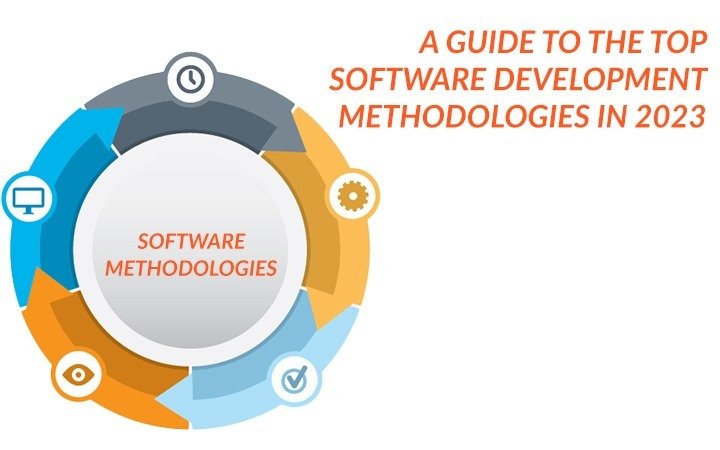To succeed in today’s fast-paced digital world, software development methodologies are crucial.
With numerous available software application development methodology to choose from, it can be overwhelming for businesses to determine which software development model and application development methodology is right for their project. Choosing the right methodology can make a significant difference in the project’s outcome, including the development process, team collaboration, and final product quality.
In this article, we will discuss the top software development methodologies of 2023, their benefits and drawbacks, and how to choose the right software development model for your business needs. Whether you’re a startup or an established enterprise, this guide will help you understand the most popular application development methodology and make an informed decision about which one to use for your next software project.
What Is a Software Development Methodology?
A software development methodology is a process or framework used to structure, plan, and control the software development process. It provides a systematic approach to software development and ensures that all stakeholders involved in the project have a clear understanding of the development process, timelines, and deliverables.
Understanding software engineering methodologies is essential for any team engaged in software development.

Types of Software Development Methodologies
Software development methodologies or in other words software development model can be categorized into two main types: traditional and Agile.
Traditional Methodologies
Traditional methodologies follow a sequential approach, where each phase of the development process is completed before moving on to the next. The most commonly used traditional methodology is the Waterfall model.
Waterfall Method
In the Waterfall model, the development process is divided into phases, starting with requirements gathering, followed by design, implementation, testing, and maintenance. In order to progress from one phase to the next, each must be completed. The Waterfall model is straightforward and easy to understand, making it a popular choice for large projects with fixed requirements.
Other traditional methodologies include the Spiral model, which is a more flexible approach that includes iterative cycles, and the V-Model, which emphasizes testing and verification throughout the development process.
Agile Methodologies

Agile methodologies prioritize collaboration, flexibility, and continuous feedback. The most commonly used Agile methodologies are Scrum, Kanban, and Extreme Programming (XP)
Scrum
Scrum is a framework that emphasizes self-organizing teams, time-boxed iterations (sprints), and a prioritized backlog of work items (user stories). The Scrum framework also includes specific roles, such as the Scrum Master, Product Owner, and Development Team.
Kanban
Kanban is a visual system that focuses on limiting work in progress (WIP) and improving flow. It emphasizes continuous delivery, constant optimization, and team empowerment.
Extreme Programming (XP)
Extreme Programming (XP) is a software development framework that emphasizes coding, testing, and continuous feedback. It includes practices such as pair programming, continuous integration, and test-driven development.
Rapid Application Development (RAD)
Rapid application development (RAD) is an Agile methodology that is particularly well-suited for projects with a high degree of uncertainty or where requirements are likely to change frequently. Rapid application development is characterized by its focus on collaboration, fast turnaround times, and a user-centered approach to software development. Rapid application development (RAD) is becoming increasingly popular among software development teams as a way to accelerate the development process and deliver high-quality software solutions to customers faster.
Different software engineering methodologies have their own strengths and weaknesses, and choosing the right one can have a significant impact on the success of a project.

Which methodology is best for software development?
Choosing the best methodology for software development depends on several factors, such as project requirements, team structure, and customer needs. Both traditional and Agile methodologies have their own strengths and weaknesses, and choosing the right one can have a significant impact on the success of the project.
For large, complex projects
For large, complex projects with well-defined requirements, a traditional methodology like Waterfall may be the best approach. Waterfall’s sequential approach allows for better planning and control, ensuring that each phase is completed before moving on to the next. This approach works well when the project requirements are unlikely to change and when there is a fixed deadline.
Projects with a higher degree of uncertainty
On the other hand, Agile methodologies like Scrum or Kanban are more suited for projects with a higher degree of uncertainty, where requirements may change frequently. Agile methodologies prioritize flexibility and continuous feedback, making it easier to adapt to changes as they occur. They also allow for faster delivery of working software and a greater focus on customer satisfaction.
Team structure and customer needs

It’s important to note that the choice of methodology should not be based solely on the project’s size or complexity. Other factors, such as team structure and customer needs, should also be considered. For example, if the customer is heavily involved in the development process and requires frequent updates and feedback, an Agile methodology may be more suitable.
By carefully evaluating software engineering methodologies and selecting the most appropriate one for a given project, software development teams can optimize their development process and achieve better results.
Whether you need to follow a traditional Waterfall model or an Agile model, we at Motivity labs have the expertise to deliver high-quality software solutions on time and within budget. Contact us today to learn more about our software development services and how we can help you achieve your business goals



